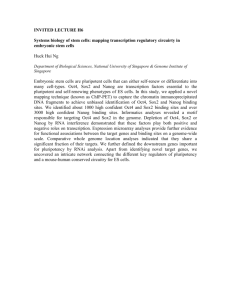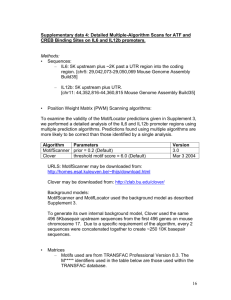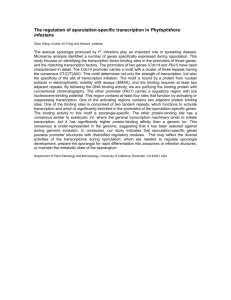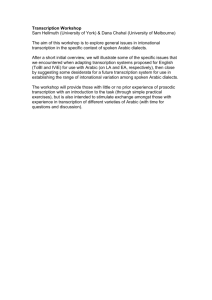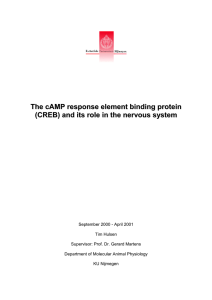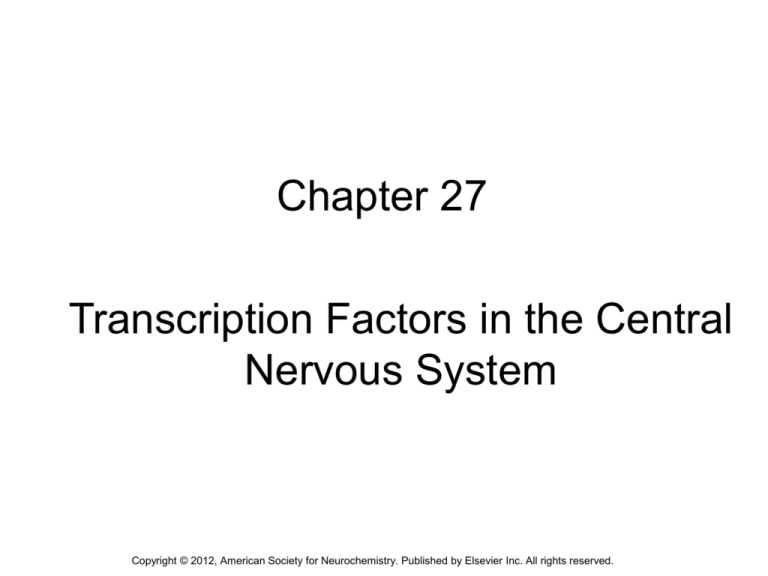
Chapter 27
Transcription Factors in the Central
Nervous System
Copyright © 2012, American Society for Neurochemistry. Published by Elsevier Inc. All rights reserved.
1
FIGURE 27-1: Formation and regulation of the transcriptional complex. The transcribed region of a gene is indicated in black.
Immediately to the right of this box, on the 5’-side, is an orange helix, indicating the TATA box sequence. These are cis -regulatory
sequences. The transcription complex binds to the TATA box and can initiate transcription when stimulated. Transcription can be
regulated by the binding of various trans-acting factors to the enhancers (blue shapes) adjacent to the TATA box. The positioning of these
sequences permits a direct interaction between trans-acting factors and the RNA polymerase II complex.
Copyright © 2012, American Society for Neurochemistry. Published by Elsevier Inc. All rights reserved.
2
FIGURE 27-2: Gene expression as a biological amplifier. Transcription is an amplification step, giving rise to thousands of mRNA
molecules from a single gene. Translation is a second amplification process, producing hundreds of protein molecules from a single
mRNA molecule.
Copyright © 2012, American Society for Neurochemistry. Published by Elsevier Inc. All rights reserved.
3
FIGURE 27-3: Epigenetic modifications. A. Histones (green) are wrapped with DNA (purple) to form a structure that resembles beads
on a string. Histone tails (black) are available sites for modification. B. Acetylation (red) by HATs (histone acetyltransferases) generates a
more open chromatin conformation. C. Histone deacetylation by HDACs (histone deacetylases) generates a more closed chromatin
conformation. D. Methylation marks (yellow) are present on CpG sites on DNA (purple.) E. Denovo methyltransferases add methyl groups
to sites on a single strand of DNA where the sites have no corresponding methylated marks on the complementary strand. F.
Maintenance methyltransferases add methyl groups when methylation is present on the complimentary strand.
Copyright © 2012, American Society for Neurochemistry. Published by Elsevier Inc. All rights reserved.
4
FIGURE 27-4: Serotonergic signaling can modulate glucocorticoid receptor (GR) expression. ERK activation occurs through
serotonin binding. MSK phosphorylates CREB. Phosphorylated CREB recruits CBP, which associates with the exon 17 promoter of GR
gene. cAMP and PKA are released via adenylate cyclase coupled to the serotonin receptor, resulting in NGFI-A expression. NGFI-A
binding to the glucocorticoid receptor gene is enhanced by the CBP binding, resulting in enhanced GR expression.
Copyright © 2012, American Society for Neurochemistry. Published by Elsevier Inc. All rights reserved.
5
FIGURE 27-5: Structure of transcription factors from different families.
Copyright © 2012, American Society for Neurochemistry. Published by Elsevier Inc. All rights reserved.
6
FIGURE 27-6: ChIP and microarray analysis of transcription. The chromatin immunoprecipitation assay is depicted on the left-hand portion of this
figure. Each of the steps leading to characterization of the DNA sequence associated with selected transcription factors is illustrated for the CREB
transcription factor. On the right-hand portion of this figure is a schematic of one method for selecting putative CREB responsive genes. Brain tissues
from a normal mouse and a CREB knockout (KO) mouse are dissected, RNA is isolated and probes are made from each tissue with the CREB+probe
giving rise to red fluorescence while the KO probe gives rise to green fluorescence. When simultaneously hybridized to an array containing thousands of
immobilized clones, any RNA that is more abundant in CREB-containing tissue would be RED; any RNA that is less abundant in CREB containing
tissue (knockout mouse) would be GREEN; and those RNAs that are present in nearly equal abundances appear as the YELLOW overlapped signal.
The RED fluorescing clones correspond to candidate genes whose transcription is stimulated by CREB, while those that are GREEN represent
candidate genes whose transcription is inhibited by CREB.
Copyright © 2012, American Society for Neurochemistry. Published by Elsevier Inc. All rights reserved.
7
FIGURE 27-7: Immunohistochemical localization of type I corticosteroid receptor (mineralocorticoid receptor) in the rat
hippocampus. A: Mineralocorticoid immunoreactivity is concentrated in pyramidal cell fields of the cornu ammons (CA2). B: High-power
photomicrograph shows that steroid-bound mineralocorticoid receptors are primarily localized to neuronal cell nuclei. (Photomicrographs
courtesy of Dr. James P. Herman, Department of Anatomy and Neurobiology, University of Kentucky.)
Copyright © 2012, American Society for Neurochemistry. Published by Elsevier Inc. All rights reserved.
8
FIGURE 27-8: Activation of glucocorticoid receptors. Glucocorticoids (red) (
)diffuse across the plasma membrane and bind to the
glucocorticoid receptor (dark orange). Upon glucocorticoid receptor binding to the steroid, the receptor undergoes a conformational
change, which permits it to dissociate from the chaperone heat shock proteins (light orange circles). The activated glucocorticoid receptor
translocates across the nuclear membrane and binds as a homo- or heterodimer to glucocorticoid response element sequences to
regulate gene transcription.
Copyright © 2012, American Society for Neurochemistry. Published by Elsevier Inc. All rights reserved.
9
FIGURE 27-9: Activation of cAMP-regulated genes. When agonists (
) bind to G protein-coupled receptors that activate dissociation
of Gs from the Gs complex, Gs will interact with the enzyme adenylyl cyclase, resulting in synthesis and increase of intracellular cAMP.
cAMP binds to the regulatory subunits (orange ovals) of protein kinase A (PKA). This binding facilitates the dissociation of the catalytic
subunits (dark orange spheres) from the PKA complex. The catalytic subunits then translocate across the nuclear membrane and
phosphorylate cAMP response element–binding protein (CREB) and CREB-related proteins. Phosphorylated CREB increases gene
transcription (right arrow).
Copyright © 2012, American Society for Neurochemistry. Published by Elsevier Inc. All rights reserved.
10
FIGURE 27-10: Immunohistochemical localization of cAMP response element binding protein (CREB) in rat hippocampal
neurons. Using a polyclonal antibody that recognizes both CREB and phospho-CREB protein, it is apparent that CREB protein is
enriched in the nucleus of pyramidal cells of the CA1 region of the hippocampus. Scale bar is 30μm. (Photomicrograph courtesy of Dr.
Stephen Ginsberg, Department of Pathology, University of Pennsylvania.)
Copyright © 2012, American Society for Neurochemistry. Published by Elsevier Inc. All rights reserved.
11
FIGURE 27-11: Mechanism for generation of activators and repressors of cAMP-stimulated transcription. The cAMP response
element binding protein (CREB) and the cAMP response element modulator (CREM) genes can give rise to alternatively spliced mRNAs,
which give rise to distinct protein products. While CREB and CREM can stimulate CRE-mediated gene expression, generation of the α, β
or forms of CREM will produce proteins that can heterodimerize with activated CREB and CREM subunits inhibiting their stimulatory
capacity. The symbols used to highlight functional regions of CREB and CREM protein are Q for the polyglutamine tract, which stimulates
transcription; D for the DNAbinding region; and Z for the leucine-zipper region, which is involved in dimerization.
Copyright © 2012, American Society for Neurochemistry. Published by Elsevier Inc. All rights reserved.
12
FIGURE 27-12: Sox2 activity is regulated by cell- or tissuespecific binding partners. The binding of cofactors or binding partners
significantly augments transcriptional activation by Sox2. The binding partner dimerizes with Sox2 and both of them bind the DNA. Each
partner binds a unique DNA sequence, while the sequence specificity for Sox2 remains the same regardless of the binding partner. In this
way the specificity and dynamic range of Sox2 activity is increased, such that, in different tissues Sox2 may activate transcription of
different genes, as shown in the cartoon. In ES cells, Sox2 may dimerize with Oct to drive expression of Nanog. In contrast, in early
neural tissue, Sox2 may dimerize with Pou to drive expression of Sox2 itself, while in retinal tissue Sox2 may dimerize with Pax6 to drive
expression of dCry.
Copyright © 2012, American Society for Neurochemistry. Published by Elsevier Inc. All rights reserved.
13

